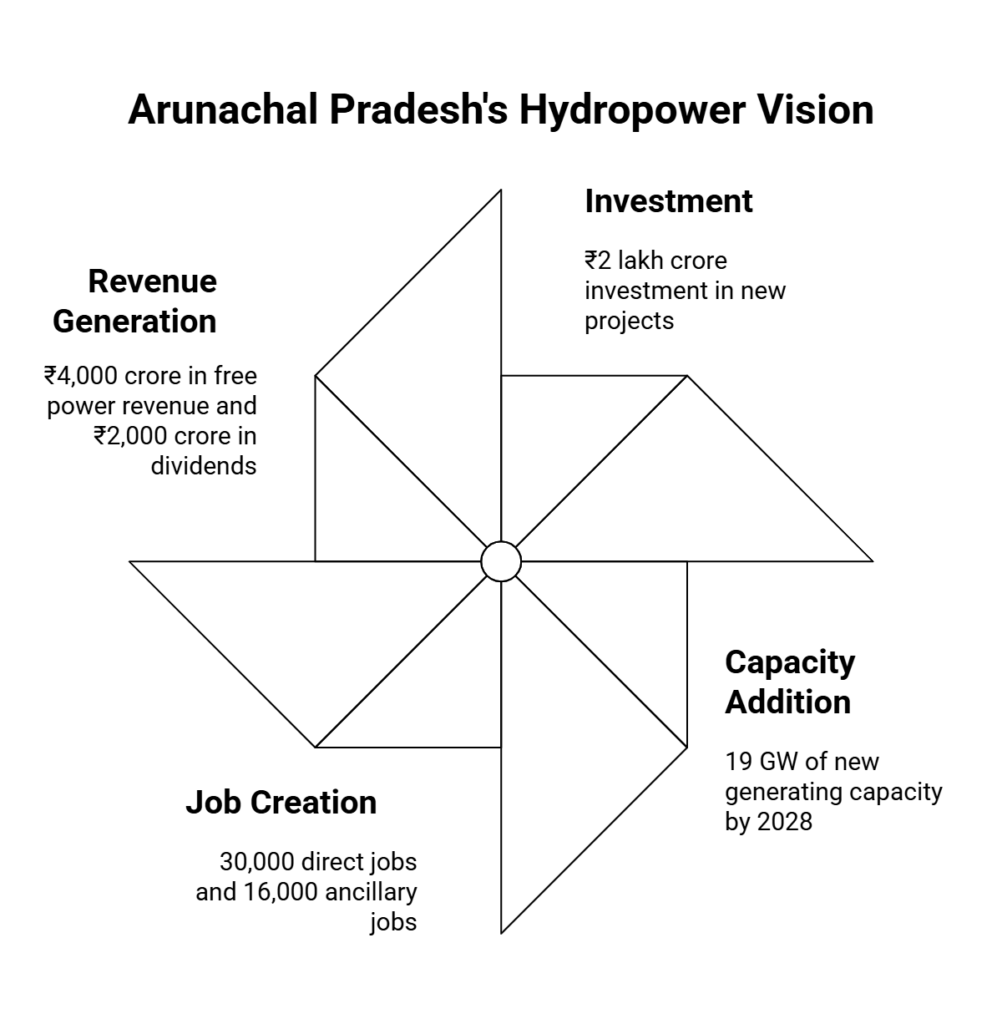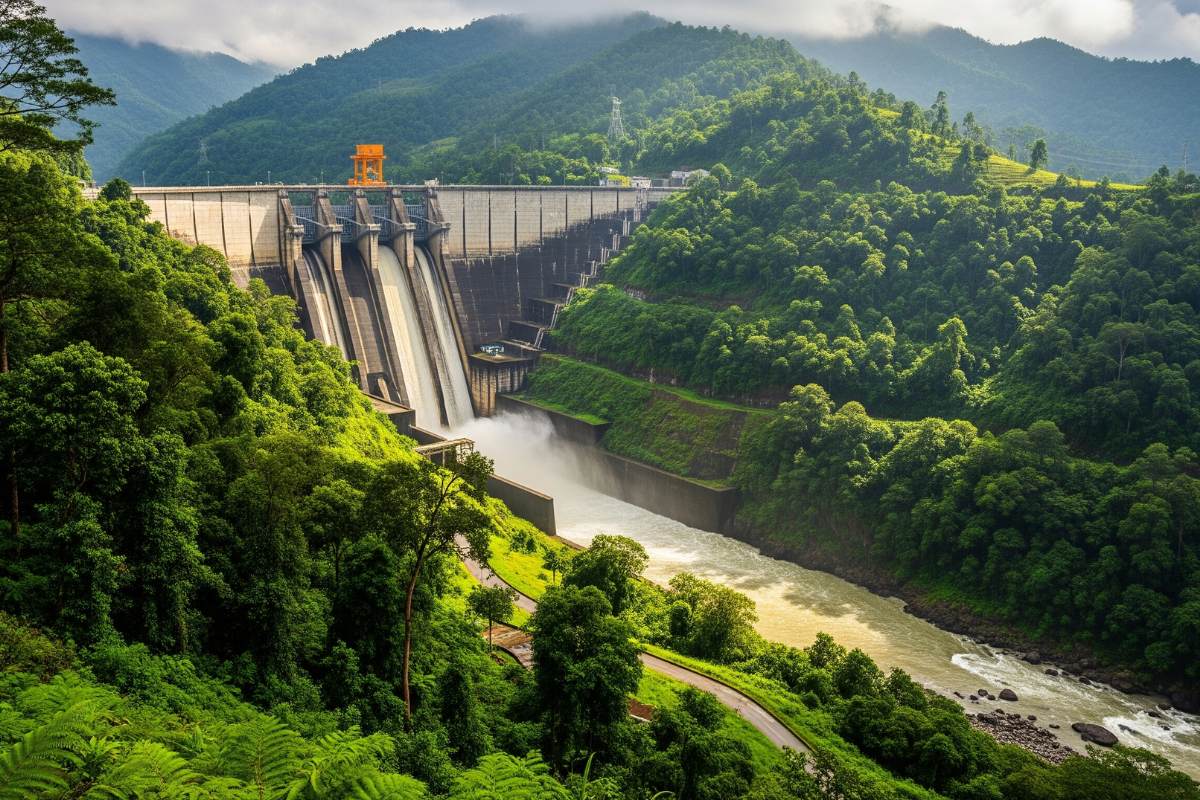Transforming the Northeast
Itanagar. A warm Independence Day. Statesmen gather. Onstage, Arunachal Pradesh Chief Minister Pema Khandu, steely, clear-eyed, speaks not of politics, but promise. His pledge? That by 2047, the rugged, forested, river-laced state of Arunachal Pradesh will stand tall as the engine room of India’s green energy future. If he’s right, a revolution is coming, not just for energy, but for jobs, industry, and the very fabric of life in this border state.
Big Goals and Bold Declarations
Chief Minister Khandu’s words cut to the heart of an unprecedented push: The “Arunachal Pradesh Energy Vision and Action Plan 2047”, a sweeping roadmap that sets targets at five, ten, and twenty-two years, declaring the upcoming decade, 2025 to 2035, as the official “Decade of Hydropower.” His government isn’t just penciling ideas into dusty ledgers. It’s launching, full throttle, into the construction and expansion of massive hydropower projects. The scale? Staggering:

- Over ₹2 lakh crore to be pumped into new hydropower initiatives within just three years.
- 19 gigawatts (GW) of fresh generating capacity to come online by 2028.
- Direct job creation for 30,000 individuals, plus another 16,000 in ancillary services.
- Annual windfall: over ₹4,000 crore in free power revenue and ₹2,000 crore in dividends to the state government’s coffers.
But numbers alone can’t capture the ambition. The state is banking on its unmatched natural potential. Key resources, mountains, gushing rivers, critical minerals like graphite and limestone, form the backbone of a push that, if successful, could rescript not just Arunachal’s economy but the broader region’s development trajectory.
The Projects That Will Change Everything
Let’s get concrete. These aren’t just boardroom dreams; they’re boots-on-the-ground projects, many already halfway up the mountain:
Major Hydropower Ventures
- 2,000 MW Subansiri Lower Hydropower Project: Racing toward completion by May 2026, this long-awaited project aims to flood the national grid with renewable electricity.
- 2,880 MW Dibang Multipurpose Project: Slated for wrap-up by February 2032, Dibang is set to become India’s largest hydro plant, with ripple effects across industry, infrastructure, and jobs.
- Siang Upper Multipurpose Project: Declared a “National Project” back in 2008, the Siang river development is shaping up as a key security and economic asset, with in-depth local consultations ongoing to address community concerns.
- Tato-II Hydro Project (700 MW): With a cabinet-approved investment of over ₹8,000 crore, this project alone is expected to churn out nearly 2,740 million units of clean power annually, while directly boosting local area development funds and job opportunities.
Hundreds of smaller hydropower projects stitch together this wider tapestry, from the 24 MW Dikshi HEP to the 7.5 MW Khangtang in Tawang, not to mention dozens of schemes both completed and under construction across the state’s valleys and ridges.
The Industrial Domino Effect
Think ripple effects, not just raw watts. The construction phase alone? It’ll demand:
- 18 million metric tonnes of cement
- 1.1 million tonnes of steel
- 90 million cubic metres of aggregates
This industrial boom brings more than just turbines. Construction, manufacturing, housing, and logistics will all see a surge, opening doors for thousands of skilled and unskilled workers.
Revenue, Dividends, and Social Impact
This isn’t just about “green energy” in the abstract. The cash flows, too, directly into state revenue streams, and, crucially, local communities:
- Annual state income: Over ₹4,000 crore from free power allocations.
- Dividends: Nearly ₹2,000 crore every year for the government, enabling ambitious spending on roads, bridges, schools, and hospitals.
- Local Area Development: ₹750 crore set aside every year for direct, grassroots improvement.
Here’s the kicker: With success, Arunachal Pradesh’s per capita income could, believe it or not, vault ahead of some of India’s biggest states by mid-century.
The Employment Tsunami
46,000 jobs. That’s the headline, but the reality is richer and more granular:
- 30,000 direct placements: Engineers, construction workers, power plant operators, scientists.
- 16,000 in ancillary industries: Hospitality, retail, logistics, supply chain, maintenance, and more.
- 7,500 local jobs: Through small hydropower schemes and their supporting businesses.
- Upskilling and training: As part of the initiative, the state is ramping up vocational and technical education to meet surging demand for green energy professionals and support staff.
All told, the employment ecosystem is set to touch nearly every family in the state.
Public-Private Partnerships and Strategic Security
Funny thing is, none of this unfolds in a vacuum. The plan leans heavily on public-private partnerships, joint ventures (like those between the North Eastern Electric Power Corporation and state authorities), and massive state and central government coordination. Why? Because the stakes, believe it or not, are not just financial. Arunachal’s northern borders touch regions of acute international interest. Some projects, especially on the strategically significant Siang river, are driven, in part, by the need to counter dam-building and hydroelectric development across the Chinese border.
It’s not just about exporting electricity or growing jobs. It’s about resilience. Security. The ability to manage rivers and resources in ways that serve Indian interests for generations.
Carbon Credits and India’s Climate Commitments
This green wave churns out more than jobs, you know, it also means slashing emissions. Arunachal Pradesh is already punching above its weight:
- 16,326 carbon credits secured in 2023–24, with nearly 7,300 more pending approval for 2024–25.
- Each carbon credit logs a reduction of 1,000 kg of CO₂.
- These credits can be traded, potentially unlocking huge new revenue streams as global carbon markets balloon beyond $10 trillion in the coming years.
As India drives towards its ambitious net-zero targets, Arunachal steps up as a beacon, proving that forests, rivers, jobs, and growth don’t have to be at odds.
Social Outreach: Beyond Steel and Stone
Chief Minister Khandu has made it clear, no bulldozers will be used without consensus. The government is working face-to-face with affected communities, especially around controversial projects like the Siang Upper Multipurpose Dam, to address displacement and compensation concerns. Transparent ongoing dialogue, frequent consultations with local leaders, and new benefits packages for project-affected families are all on the table.
“Empowerment” here isn’t just a buzzword. Khandu and his ministers frame these hydropower projects as vehicles for social upliftment, as much about health, education, and resilient communities as they are about megawatts and turbines.
Arunachal Pradesh as a National Blueprint
Zoom out. What’s going on in Arunachal Pradesh is being closely watched across India, because if a largely undeveloped, mountainous border state can pull off a green energy transformation of this scale, it serves as a model for the whole country.
- Aligning “Make in India” with “Green in India” by leveraging local minerals for solar panels, batteries, and electric mobility.
- Linking energy, environment, and economic reforms in a holistic, people-first way.
- Pioneering public-private cooperation and rapid project revival, jump-starting previously stalled ventures with new governance and finance models.
- Creating a future-ready workforce through targeted educational investments.
Key Challenges and Ongoing Debates
It isn’t all sunshine and river breeze. There are serious challenges; environmental activists raise well-founded alarms about biodiversity loss, flooding risk, and the long-term impacts of megadams on indigenous communities. Public protests over the Siang river project, in particular, have forced the government to promise more transparency, compensation, and environmental review.
Infrastructure, too, is a work in progress. Roads, bridges, and transmission lines must be built, often from scratch, in some of the most rugged terrain on earth. Bureaucratic hurdles, funding bottlenecks, and the ever-present threat of natural disasters put even the best-laid plans at risk.
What’s Next for Arunachal Pradesh?
Here’s the bottom line: The “Decade of Hydropower” is not just a catchy tagline. It’s a focused, comprehensive push to place Arunachal Pradesh at the epicenter of India’s clean energy future. By 2035, the state hopes to:
- Generate up to 58,000 MW of hydropower
- Build stable and supportive policy and regulatory frameworks for the green industry
- Foster a dynamic, employment-rich, high-skill economy
- Turn the Northeast into the largest exporter of green electricity in India
“Green energy will be our strength, our export, and our identity,” says Chief Minister Pema Khandu. Lofty words. But in Arunachal Pradesh, the turbines are spinning, the jobs are growing, and an energy revolution is, believe it or not, already underway.






















